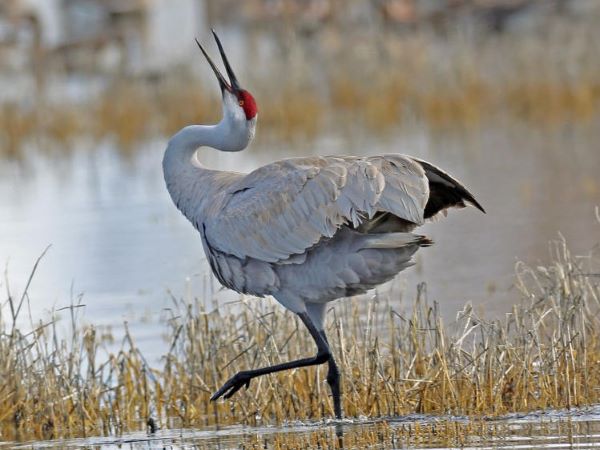The birds are coming, and we encourage everybody to get outside and enjoy spring birding…
Debbie Schlenoff
 Sports teams have often branded themselves with animal monikers (hello, Duck fans!). Football teams borrow from our feathered friends—the Arizona Cardinals, Atlanta Falcons, Baltimore Ravens, Philadelphia Eagles, Seattle Seahawks. So it is sadly ironic that the massive football stadium under construction in Minneapolis will result in a large and unnecessary number of bird deaths. The new Vikings stadium, located on a migratory flyway next to the Mississippi River, features large expanses of glass (200,000 square feet) and is expected to kill thousands of birds if built as originally designed. Birds don’t see glass and will attempt to fly through the invisible barrier, only to be brought up short when they collide with the glass. The collisions are often fatal.
Sports teams have often branded themselves with animal monikers (hello, Duck fans!). Football teams borrow from our feathered friends—the Arizona Cardinals, Atlanta Falcons, Baltimore Ravens, Philadelphia Eagles, Seattle Seahawks. So it is sadly ironic that the massive football stadium under construction in Minneapolis will result in a large and unnecessary number of bird deaths. The new Vikings stadium, located on a migratory flyway next to the Mississippi River, features large expanses of glass (200,000 square feet) and is expected to kill thousands of birds if built as originally designed. Birds don’t see glass and will attempt to fly through the invisible barrier, only to be brought up short when they collide with the glass. The collisions are often fatal.
Modifications to the building design can make a difference, however. Bird-friendly glass has low reflectivity on the outside and contains a “fritted” pattern of dots that is visible to the birds, but does not impede the view for people. When the Vikings stadium developers refused to modify the design to incorporate the bird-safe glass, the National Audubon Society, Minnesota Audubon Society, American Bird Conservancy, and others requested that the National Football League (NFL) alter the plans for the stadium. The new stadium, expected to open in two years, will cost close to $1 billion. The recommended adjustments to decrease bird fatalities would cost about one-tenth of one percent (0.1%) of the stadium cost. Experts contend that the use of the bird-friendly glass will actually pay for itself in energy efficiency.
Just how bad is the bird-collision problem? A 2014 study by Loss, Will, Loss, and Marra found that bird collisions kill between 365 and 988 million birds every year in the United States. Some species are disproportionately represented in the body counts, including species of conservation concern such as Golden-winged Warbler, Canada Warbler, Kentucky Warbler, and Wood Thrush. According to the quantitative analysis, building collisions rank second in sources of direct human-caused mortality (feral and free-ranging cats kill the most birds per year).
Over 200 species of birds are suffering significant population declines in this country, and it seems a travesty to contribute to their demise when it is preventable. The Minneapolis City Council passed a resolution on August 1 to support having the stadium fitted with bird-safe glass. They note that the city is contributing more than the cost of modification in local sales-tax revenue and that “the interests of the people of Minneapolis should be honored.” Other voices are being heard. As of August 1, over 46,000 people have signed a petition. You too can sign by going to https://secure.audubon
.org/site/Advocacy?cmd=display&page=UserAction&id=1717.
I hope in the future that “fourth down” will not mark the beginning of a long count of downed birds and that “end zone” will not be a reference to the significance of the Vikings stadium for migrating birds. “Dead ball” is OK; dead bird is not. As I write this in midsummer, I don’t know the outcome of the various meetings with the NFL authorities. After the huddle, let’s hope the NFL exhibits sportsmanlike behavior and we can update this story with a winning score for the birds.
For tips on reducing bird collisions with windows at home, see www.laneaudubon.org/conservation/issues/bird-window.
Reference:
Loss, Scott R., Tom Will, Sara S. Loss, and Peter P. Marra. 2014. Bird–Building Collisions in the United States: Estimates of Annual Mortality and Species Vulnerability. The Condor 116(1):8–23.



